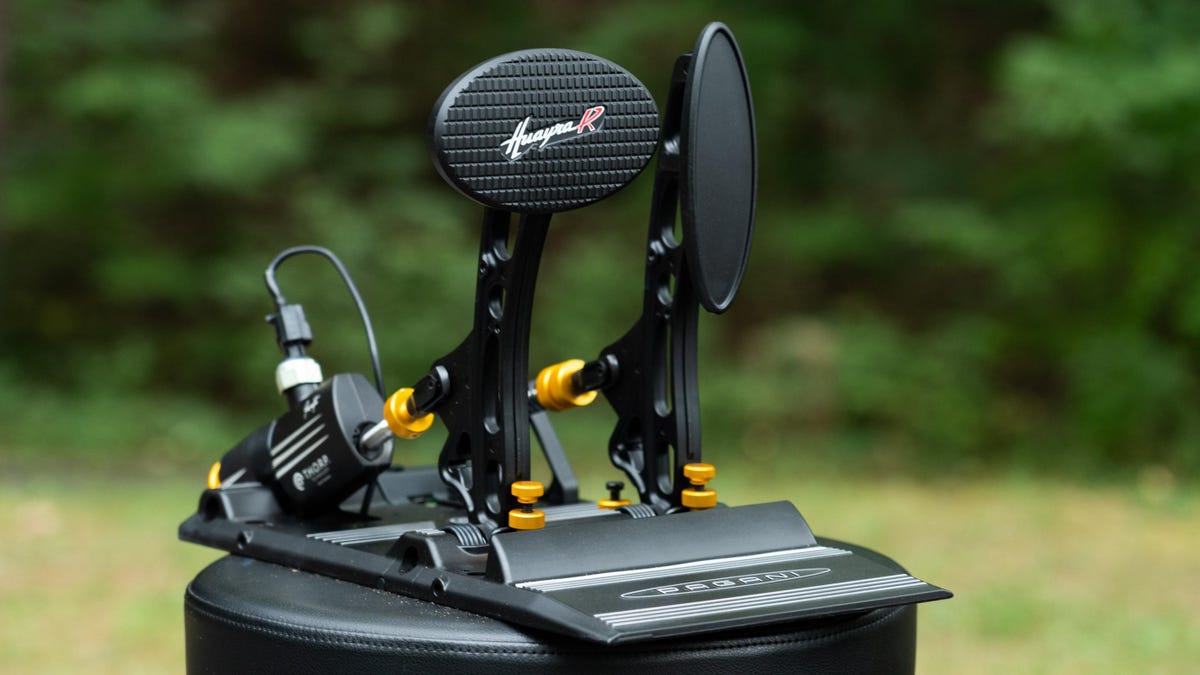How to Drive a Pagani Huayra R at Home, For Just $2,000

Photo: Tim Stevens
At this year’s Motorsports Reunion at Weathertech Raceway Laguna Seca, I was lucky enough to be among the first people in the world to hear the Pagani Huayra R run at full song. It was, no surprise, an aural delight of symphonic proportions, about as good as a V-12 can possibly sound. Horacio, sir, ya done good.
Sadly, that’s about as close as most of us will ever come to truly experiencing this $3.5 million, 850-horsepower miracle of modern machinery. But, dear reader, what if I told you there’s a way you can drive one at home for a fraction of the cost? You’d probably tell me that’s impossible, and then I’d say you’re basically right, and then we’d have a good laugh about the joys of capitalism. However, it is possible to get a taste of Pagani life at home, with the $1,999 Asetek SimSports Pedal Set Pagani Huayra R Edition.
Photo: Tim Stevens
Asetek is a recent entrant into the world of high-end sim racing components, offering a series of top-shelf pedal systems. The company has partnered with Pagani to replicate the look and feel of the Huayra R’s pedals, creating a PC-compatible set ready for your favorite race sim.
Out of the box, it’s immediately apparent that this is serious equipment. Everything is precision-machined or cast aluminum, and the look is stellar, like real racing kit. At Laguna I was able to peek inside the driver’s footwell of the real car and, sure enough, the Asetek unit’s pedals are basically identical. Only the levers that connect the pedal faces to the mechanisms behind them are slightly different, but that’s for an important reason: Sim racing pedals don’t work like real racing pedals.
G/O Media may get a commission
Up to 85% off
Jachs NY Summer Sale
Styles starting at $10
This sitewide sale will prepare you for any style situation that may arise in the transition between seasons—whether it be a henley and jeans or a button up and chino shorts moment.
Photo: Tim Stevens
In fact, most PC-compatible pedals don’t work like Asetek’s pedals, either. The average pedal set, your Logitechs and Thrustmasters and Fanatecs and the like, uses either a hall sensor or a potentiometer, electronics that measure how far a given thing has moved or twisted. That type of system works great for throttle or clutch, but not for brakes.
That’s because the movement of a car’s brake pedal doesn’t really dictate the braking force. Instead, hydraulic pressure built up by compressing a piston is how foot motion gets turned into stopping power. Stepping on a car’s brake pedal applies more pressure, which means more squeeze on the brake pads. Even if the pedal doesn’t move, the pressure increases.
To simulate this, Asetek uses a system called THORP: Twin Hydraulic Opposing Rapid Piston. It’s a weird name for an interesting combination of a soft bushing paired with an actual hydraulic piston. The compressibility of the bushing simulates initial brake-pedal travel; then, when the bushing is fully squished, the hydraulic system kicks in and the pedal goes totally firm. The system is fully adjustable, with multiple bushings and springs, but is configured out of the box to exactly mimic the Pagani’s real-world brake pedal feel.
Photo: Tim Stevens
By way of context, I use a Fanatec Clubsport pedal system for my sim racing, which uses a pressure-sensitive load cell to replicate brake feel. The Asetek system is far more stiff and, therefore, more precise.
Setup was easy — just one USB-C cable. But driving the Huayra R turned out to be a bit tricky, and not just because of 850 hp. It turns out, the Huayra R isn’t officially available in any sim-racing game that I could find. But, as any sim racer knows, there are ways. A little Googling uncovered an unofficial mod for Automobilista. The game happens to be on sale for just $18 on Steam right now, but you’ll have to find the mod yourself.
I also ran laps in a Zonda R in Assetto Corsa and tried out a handful of cars in iRacing. Across the board, I was impressed. That odd, oversized oval brake pedal took a little getting used to, but the pedal feel is superb. Trail-braking and modulation are predictable and smooth. I’m addicted to these pedals.
Photo: Tim Stevens
It’s not all good news, though. Adjust all you want, the brake pedal is too firm to replicate the feel of a street car. The brake is so stiff, you’ll need to mount the pedal set in a proper sim racing chassis to use it. Also, the lack of a clutch pedal is a bummer at this price — but then, the Huayra R doesn’t have one, and so I suppose neither should this.
And there’s the cost: $1,999 is about double the cost of Asetek’s functionally identical Invicta pedals. The provenance here, though, makes that premium a little easier to swallow. Easier to swallow than the down payment on a Pagani, anyway.



